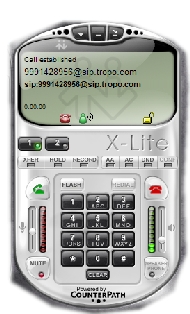I have been writing lately about my experiences setting up several unified communications applications, most recently one involving an open government project with hosted service provider Tropo. The projects were cell-phone centric, and assumed I would be issuing commands into my aged Samsung model while I was managing other activities—driving, drinking coffee while driving, etc. 
I do engage with larger devices, and with my new MacBook Pro I am now evolving a nomadic lifestyle. In between appointments, I’ll pitch camp at Starbucks or another WiFi friendly oasis and fit in a few licks of work before I pack up.
It works out well for me, because now I can take advantage of free VoIP calls when I’m out in the field. Thankfully, Tropo (and others) supports the open-standards connection protocol SIP, which makes calling into voice services, such as Tropo’s, incredibly easy.
I have been following Session Initiation Protocol (SIP) since the early days, and when SIP software became available and downloadable from the Internet, I knew I had to try it out.
To take advantage of SIP, you’ll need to access an outgoing SIP proxy server, which handles a number of functions: resolving SIP’s email-like address to real IP ones, routing the SIP connection requests (called an invite) to the called device, and then handling the bitty-gritty of “ringing” the other end and inviting that end-point into the conversation.
(By the way, SIP is not VoIP. SIP is the part of VoIP that involves connecting to VoIP devices and other services and applications. For those so inclined, some of the underlying complexity of SIP signaling can be sampled here.)
For my softphone, I’ve been partial to the snazzy X-Lite gadget, with its phone-like skin. My first test was really an exercise to confirm that SIP and free VoIP calls reached the expectations set by the evangelist community. They did.
The issue for me then was that there wasn’t all that many folks or services with SIP addresses I could call, and so my X-Lite phone lay dormant on my Windows desktop.
Obviously, in more recent times there’s been an upswing in SIP deployments (especially in the enterprise-verse). So when I set up my Tropo account, I noted that along with my standard plain-old telephone number to my app, there was also an email-like SIP address. That’s the SIP phone number.
Fortunately, there are freebie services on the Web that can do the proxying for you. I chose SIP2SIP. Relatively straightforward: it was just a matter of entering my user name, domain, and proxy address supplied by SIP2SIP into my X-Lite account page.
 Once I had that done and dusted, I watched as my X-Lite registered its SIP profile information with the SIP2SIP proxy server.
Once I had that done and dusted, I watched as my X-Lite registered its SIP profile information with the SIP2SIP proxy server.
Now I was officially on-line as far as the SIP world was concerned. I entered the Tropo SIP address of my Gov 2.0 project into the X-Lite contacts and then initiated my call.
It all worked flawlessly. (Though I am experiencing problems with X-Lite recognizing the MacBook’s internal speaker and mike; I used a spare USB-headset instead.)
I’ll be exploring more SIP goodies going forward. Let you know what I come up with.
Related articles by Zemanta
- CounterPath and Digium(R) Launch Asterisk-Based Multimedia Softphone (newswire.ca)
- SIP Forum’s SIPit 26 to Take Place in Kista, Sweden, May 17-21, 2010 (eon.businesswire.com)


![Reblog this post [with Zemanta]](http://img.zemanta.com/reblog_e.png?x-id=6488cdfe-5c58-43c9-8c45-3b5a1b0e4977)